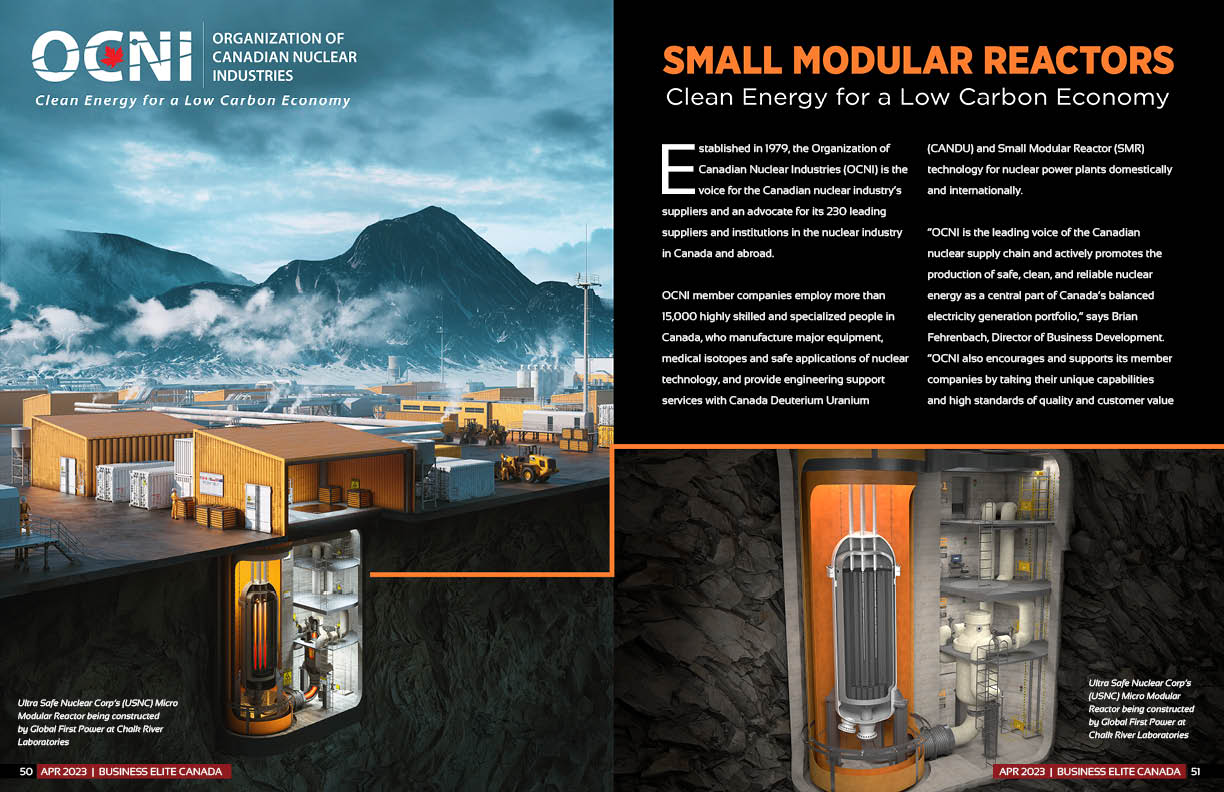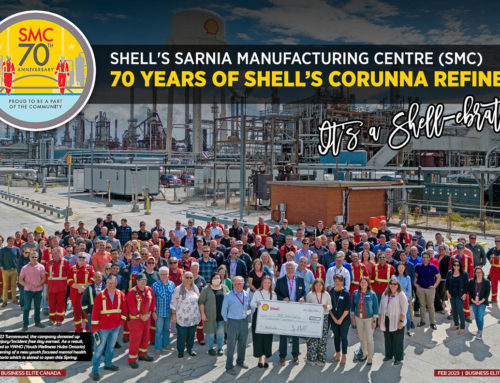Established in 1979, the Organization of Canadian Nuclear Industries (OCNI) is the voice for the Canadian nuclear industry’s suppliers and an advocate for its 230 leading suppliers and institutions in the nuclear industry in Canada and abroad.
OCNI member companies employ more than 15,000 highly skilled and specialized people in Canada, who manufacture major equipment, medical isotopes and safe applications of nuclear technology, and provide engineering support services with Canada Deuterium Uranium (CANDU) and Small Modular Reactor (SMR) technology for nuclear power plants domestically and internationally.
“OCNI is the leading voice of the Canadian nuclear supply chain and actively promotes the production of safe, clean, and reliable nuclear energy as a central part of Canada’s balanced electricity generation portfolio,” says Brian Fehrenbach, Director of Business Development. “OCNI also encourages and supports its member companies by taking their unique capabilities and high standards of quality and customer value to offshore nuclear markets through partnerships with local suppliers, power plant designers, nuclear utilities and government agencies.”
Focusing on SMRs
Called “the next great opportunity for Canada”, Small Modular Reactors (SMRs) represent the next great opportunity for Canada—providing a source of safe, clean, affordable energy, opening opportunities for a resilient, low carbon future and capturing benefits for Canada and Canadians.
SMRs are a promising new technology that could unlock a range of benefits: economic, geopolitical, social, and environmental. Canada’s SMR Action Plan brings together essential enabling partners, leveraging their strengths to lock-in these benefits and lead the world on SMRs.
“SMRs differ from CANDU both in their size (Small), their construction methodology (Modular) and in some cases their more advanced technology,” says Fehrenbach. “This presents a large list of benefits depending on the technology chosen.”
What does this mean for Canada?
All of the SMRs under licensing consideration in Canada can be placed into one of three categories. The first group, Stream One, is defined in Canada’s SMR Action Plan as being focused on the deployment of grid-scale reactors to provide energy to consumers. Ontario Power Generation has initiated Canada’s first grid-scale SMR project (~300 megawatt) to be constructed at the Darlington site, followed by the first of up to four subsequent units in Saskatchewan anticipated to be in service by 2034. Additionally, Ontario Power Generation intends to evaluate the potential for the deployment of additional SMRs at the Darlington site. This “fleet” approach would identify a common SMR technology that could be more efficiently deployed in multiple jurisdictions.
Site preparation is now underway for a BWRX-300 at OPG’s Darlington New Nuclear Project site in Clarington, Ontario, with construction expected to be complete by the end of 2028. This will be the first grid-scale SMR in North America.
“A 1MW power source could power approximately 1,200 average Canadian homes over a year, so even a ‘small’ 300 MW reactor can still provide a lot of electricity,” says Fehrenbach. “As more computer intensive high-tech companies move to Canada and its industrial base of steel and resource heavy industries look to modernize, these facilities may draw as much as 100 MW for themselves. This brings us to a second category of SMRs which includes those defined as Stream 2 in Canada’s SMR Action Plan. Stream 2 is focused on the use of nuclear technology to help decarbonize industry by creating both energy and steam through the use of 4th generation advanced SMR designs.
Two of these designs will be developed in New Brunswick through the construction of a project at the Point Lepreau nuclear generating station. The ARC Clean Energy technology is anticipated to be commissioned in 2029 and generating power by 2030, to be followed by Moltex Canada’s SSR-W, according to the SMR Action Plan.
Stream Two and other ‘Generation IV’ technologies are very advanced reactors of different designs that present a lot of opportunities for Canada to reduce carbon emissions and provide additional benefits to industry, says Fehrenbach. Ranging in size from 60 megawatts to 300 megawatts, these models vary from molten salt reactors to high temperature gas reactors. These innovative designs present opportunities to produce not just electricity but also hydrogen, steam, heat and medical isotopes, depending on the customers’ needs. Other Generation IV SMRs being considered for these applications in Canada include Terrestrial Energy’s IMSR and X-Energy’s Xe-100.
“Finally, Stream Three is focused on the provision of advanced reactors to off-grid or remote communities. This micro-SMR class with units below 10 megawatts is ideal for small, stand-alone sites and also industrial applications,” says Fehrenbach. “Westinghouse Canada’s eVinci micro SMR can be shipped anywhere in the world in three sea cannisters, for example. In Chalk River, Ontario Power Generation and Ultra Safe Nuclear Corporation have a join venture called Global First Power that is also producing a micro-SMR.”
All seven of these Canadian companies producing SMRs are taking advantage of the inherent benefits of SMRs over large nuclear—Smallness and Modularity.
“Traditional, large nuclear plants require a very large upfront expenditure that secures 30+ years of clean, stable electricity,” says Fehrenbach. “These are suitable for large, baseload applications to supply a very large amount of reliable electricity. Now, with the introduction of SMRs, the provinces and industry have a smaller, more nimble and less-capital intensive option to ‘round out the corners’ of our electricity grid. High carbon producing industry can now consider putting an SMR or micro-SMR on their site to provide clean electricity, heat, steam or other applications. The smallness of SMRs will enable their deployment beyond the ranges of large nuclear plants.”
The second feature is Modularity, which means that the reactors are designed to be built and delivered module by module to site and then constructed together. “This approach reduces the cost, time and risks associated with long mega-construction projects,” says Fehrenbach. “The modularity also helps Canadian companies compete globally because the modules are more easily shipped internationally. Finally, as we envision the deployment of many SMRs across Canada the modularity also allows cost efficient replication over time.”
Canada’s SMR Action Plan
Canada’s SMR Action Plan is Canada’s plan for the development, demonstration and deployment of SMRs for multiple applications at home and abroad, and is a fantastic example of how the nuclear industry, Provincial Governments and Federal Government are all working together to deploy SMRs across the country.
OCNI plays a pivotal role in this plan with three specific actions: Develop a pan-Canadian supply chain; Promote the application of Advanced Manufacturing Methodologies to reduce SMR cost; Promote SMR workforce diversity and Indigenous inclusion.
It is OCNI’s position that as Canada looks to deploy SMRs across the country its important that each region is able to benefit from the tremendous economic opportunities that the nuclear industry provides. For capacity and economic benefits, its vital to build out the nuclear supply chain across Canada, starting in the provinces that have already signed onto new nuclear.
In response, OCNI has created the Ready4SMR program to help companies in other industries transition to the nuclear industry. “From pumps to valves, cables to filters and skilled trades as well, there are many small and medium sized companies that are interested in SMRs,” says Fehrenbach. “Ready4SMR brings these companies together with the experts who can analyze their operations and existing management systems and create a plan to transition to nuclear, ultimately being ‘qualified’ as a nuclear supplier by a nuclear utility. And, since nuclear is so well standardized, a company that is ‘qualified’ in New Brunswick is also able to meet the requirements of other nuclear utilities across Canada, opening the door to the entire domestic nuclear industry.”
OCNI also provides access for our members to nuclear opportunities around the world, meaning that companies who transition to the nuclear/SMR industry today will have the opportunity to be leaders in the global industry that is expected to reach $140B annually.
“As we build new nuclear industrial regions we also have the opportunity to make sure that these incredible economic benefits are available to communities who have not traditionally benefited in the past, such as First Nations, Metis and Inuit communities,” says Fehrenbach. “OCNI works closely with Indigenous associations to identify and prioritize engagement and education on topics across the nuclear spectrum, including workshops on the economics of financing and equity participation in new nuclear development. Skilled trades and other small companies that today support Uranium mining in northern Saskatchewan, for example, are excellent candidates to also work on new nuclear projects. Communities in the far north are looking to potentially move to micro-SMRs to replace diesel generated electricity, and want the education and opportunities to leverage this transition to their benefit.”
In addition to energy security the world is moving towards a carbon free economy where electricity will be used to replace combustible energy sources in transportation, industry and shipping. This massive transformation is estimated to require as much 120 gigawatts (GW) to achieve nationally, from all clean energy sources. Ontario’s Independent Electricity System Operator’s (IESO) 2022 Pathways to Decarbonization Report suggests that Ontario alone could require 18,000 new MW of nuclear energy by 2050, representing replacement power for the Pickering Nuclear Station as well as new nuclear. SNC Lavalin’s Engineering Net Zero report suggests a need for 5 to 7 GW of clean energy including nuclear every year across Canada for thirty years. “This is a staggering amount of nuclear energy that will require SMRs and large nuclear to achieve,” says Fehrenbach. “By strategically placing SMRs the provinces can also avoid having to build out some new transmission lines to more remote locations, while at the same time increasing the capacity of our current transmission lines that run from large nuclear sites.”
While SMRs are currently the primary focus for development, OCNI continues to support the deployment of large nuclear stations and the life-extensions of the existing CANDU fleet that provides Canada with reliable base-load generation.
As the former Minister of Natural Resources, Seamus O’Regan, said, “SMRs offer the next great opportunity for Canada. This work is enabling us to double down on our common mission: a net-zero economy by 2050; a global economy that continues to grow; a strong path for reconciliation with Indigenous peoples; and an energy future that leaves no one behind.”
For more information, please visit www.ocni.ca






